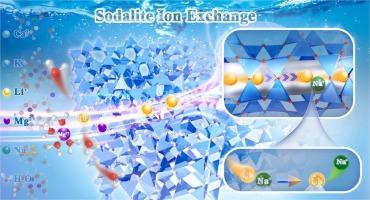通过钠盐离子交换实现Li+和Mg2+的精确分离,有助于从低质量卤水中提取锂
IF 11.3
1区 环境科学与生态学
Q1 ENGINEERING, ENVIRONMENTAL
引用次数: 0
摘要
具有精确分离Li+和Mg2+的吸附剂具有从低质量盐水中提取锂的巨大潜力,以缓解锂供应短缺。沸石以其独特的阳离子交换能力成为吸附废水中重金属的优良吸附剂。在此,我们利用Li+和Mg2+之间离子交换动力学的差异来实现高效的锂提取。钠石(SOD)、NaA和NaX分子筛的离子选择性吸附行为与其孔径成反比(分别为2.8、4.1和7.4 Å)。只有小孔SOD表现出较大的Li+和Mg2+动力学差异,才能优先捕获Li+,而Mg2+进入孔隙的速度较慢,从而使交换的Li+得以保留。从离子脱水、离子迁移和离子交换三个步骤出发,揭示了SOD中Li+和Mg2+的交换途径以及各步骤所需的能量差。ΔELi <; ΔEMg的脱水自由能、迁移能和交换能势垒确定了Li+ >; Mg2+的动力学速率顺序,从而有利于Li+的优先捕获,使Li+和Mg2+能够分离。通过对超氧化物歧化酶的再生周期、间歇合成和颗粒性能的研究,突出了其在实际卤水中提取锂的潜在价值。本文章由计算机程序翻译,如有差异,请以英文原文为准。

Precise Li+ and Mg2+ Separation Enabled by Sodalite Ion Exchange Contribute to The Lithium Extraction from Low-Quality Brines
Adsorbents with accurate Li+ and Mg2+ separation have substantial potential for lithium extraction from low-quality brines to alleviate lithium supply shortages. Zeolites have become superior adsorbents for heavy metal adsorption in wastewater due to their unique cation exchange capacity. Herein, we utilize the difference in ion exchange kinetics between Li+ and Mg2+ to achieve efficient lithium extraction. The ion-selective adsorption behavior of sodalite (SOD), NaA and NaX zeolites is inversely proportional to their pore size (2.8, 4.1 and 7.4 Å, respectively). Only small-pore SOD exhibits large Li+ and Mg2+ kinetic differences to achieve prioritized Li+ capture, while Mg2+ enters the pores more slowly, allowing the exchanged Li+ to be retained. Starting from the three steps of ion dehydration, ion migration and ion exchange, the exchange pathways of Li+ and Mg2+ in SOD and the energy differences required in each step are revealed. The dehydration free energy, migration energy and exchange energy barriers of ΔELi < ΔEMg confirm the kinetic rate order of Li+ > Mg2+, thus facilitating preferential Li+ capture and enabling Li+ and Mg2+ separation. This study of the regeneration cycle, batch synthesis and particle performance of SOD highlights its potential value for lithium extraction in actual brines.
求助全文
通过发布文献求助,成功后即可免费获取论文全文。
去求助
来源期刊

Journal of Hazardous Materials
工程技术-工程:环境
CiteScore
25.40
自引率
5.90%
发文量
3059
审稿时长
58 days
期刊介绍:
The Journal of Hazardous Materials serves as a global platform for promoting cutting-edge research in the field of Environmental Science and Engineering. Our publication features a wide range of articles, including full-length research papers, review articles, and perspectives, with the aim of enhancing our understanding of the dangers and risks associated with various materials concerning public health and the environment. It is important to note that the term "environmental contaminants" refers specifically to substances that pose hazardous effects through contamination, while excluding those that do not have such impacts on the environment or human health. Moreover, we emphasize the distinction between wastes and hazardous materials in order to provide further clarity on the scope of the journal. We have a keen interest in exploring specific compounds and microbial agents that have adverse effects on the environment.
 求助内容:
求助内容: 应助结果提醒方式:
应助结果提醒方式:


